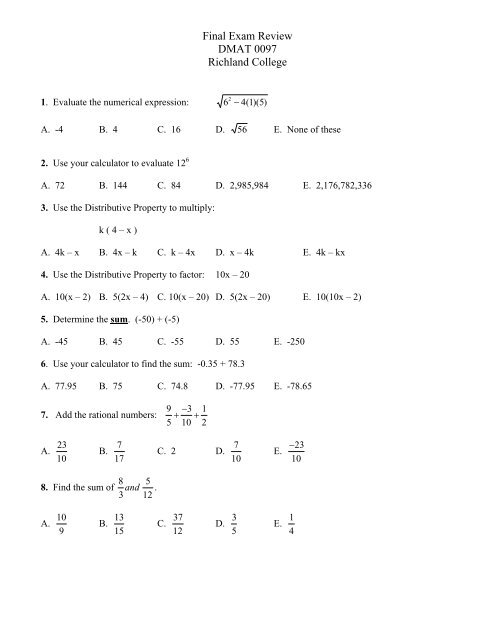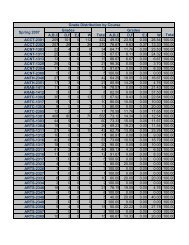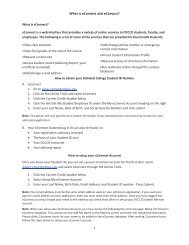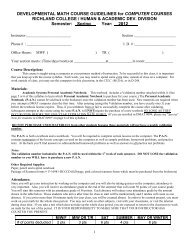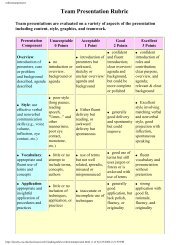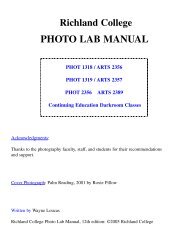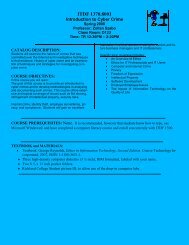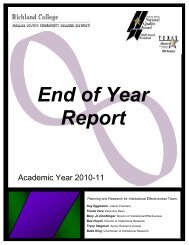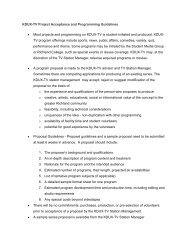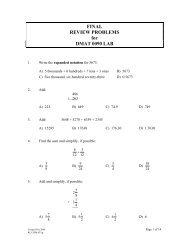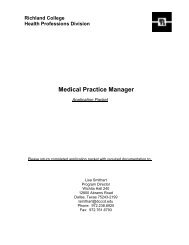Final Exam Review DMAT 0097 Richland College
Final Exam Review DMAT 0097 Richland College
Final Exam Review DMAT 0097 Richland College
You also want an ePaper? Increase the reach of your titles
YUMPU automatically turns print PDFs into web optimized ePapers that Google loves.
<strong>Final</strong> <strong>Exam</strong> <strong>Review</strong><br />
<strong>DMAT</strong> <strong>0097</strong><br />
<strong>Richland</strong> <strong>College</strong><br />
1. Evaluate the numerical expression: 6 2 4()(5)<br />
1<br />
A. -4 B. 4 C. 16 D. 56 E. None of these<br />
2. Use your calculator to evaluate 12 6<br />
A. 72 B. 144 C. 84 D. 2,985,984 E. 2,176,782,336<br />
3. Use the Distributive Property to multiply:<br />
k ( 4 – x )<br />
A. 4k – x B. 4x – k C. k – 4x D. x – 4k E. 4k – kx<br />
4. Use the Distributive Property to factor: 10x – 20<br />
A. 10(x – 2) B. 5(2x – 4) C. 10(x – 20) D. 5(2x – 20) E. 10(10x – 2)<br />
5. Determine the sum. (-50) + (-5)<br />
A. -45 B. 45 C. -55 D. 55 E. -250<br />
6. Use your calculator to find the sum: -0.35 + 78.3<br />
A. 77.95 B. 75 C. 74.8 D. -77.95 E. -78.65<br />
7. Add the rational numbers:<br />
9<br />
5<br />
3<br />
10<br />
<br />
1<br />
2<br />
A. 23<br />
10<br />
B.<br />
7<br />
17<br />
C. 2 D.<br />
7<br />
10<br />
E.<br />
23<br />
10<br />
8. Find the sum of 8 5<br />
and .<br />
3 12<br />
A. 10 9<br />
B.<br />
13<br />
15<br />
C. 37<br />
12<br />
D.<br />
3<br />
5<br />
E. 1 4
<strong>DMAT</strong> <strong>0097</strong> <strong>Final</strong> <strong>Exam</strong> <strong>Review</strong> Page 2<br />
9. Perform the indicated operations:<br />
3 1<br />
3 8<br />
4 2<br />
A. 15<br />
34<br />
B.<br />
15<br />
136<br />
C. 34<br />
15<br />
D.<br />
2<br />
255<br />
E. 3 8<br />
10. Perform the indicated operation:<br />
7 5<br />
<br />
16 8<br />
<br />
<br />
<br />
A. 3<br />
16<br />
B.<br />
17<br />
16<br />
C.<br />
3<br />
16<br />
D.<br />
17<br />
16<br />
E. 1 2<br />
11. Perform the indicated operation: (-1)(-1)(-4)(-1)(-3)<br />
A. 12 B. -12 C. -10 D. 10 E. -36<br />
12. Perform the indicated operations:<br />
247 9<br />
3<br />
2 4<br />
A. 128 B. 59.5 C. 28.6 D. 64 E. 38.92<br />
13. Find the area of the figure below.<br />
A. 396<br />
1089<br />
B.<br />
4<br />
11<br />
C. 6 7<br />
D. 3<br />
11<br />
E.<br />
4<br />
363<br />
14. Perform the indicated operations: 12 [ 6 ( 3)]<br />
A. 6 B. 2 C. -2 D. 1<br />
3<br />
E. -6
<strong>DMAT</strong> <strong>0097</strong> <strong>Final</strong> <strong>Exam</strong> <strong>Review</strong> Page 3<br />
15. Divide: 86.47 (-4.47)<br />
A. 19.34 B. -19.34 C. -19.35 D. -18.35 E. None of these<br />
16. Simplify the expression: - (x + 3) + (4 + 2x)<br />
A. –x + 1 B. –x – 1 C. x + 1 D. x – 1 E. 3x + 7<br />
17. Combine the like terms to simplify the expression: ab + 3ac – 2ab + 5ac<br />
A. 8ac – ab B. ab + 8ac C. -3ab + 8bc D. ab – 8ac E. None of these<br />
18. In which quadrant does the point (-3, 5) lie<br />
A. QI B. QII C. Q III D. QIV E. x-axis<br />
19. In which possible quadrant(s) could the point lie The coordinates of the point are described as:<br />
“The second coordinate is negative”.<br />
A. QI or QII B. QII or QIII C. QIII or QIV D. QI or QIII E. QII or QIV<br />
20. Evaluate the expression: x 2 + 4x – 2 for x = -4<br />
A. 30 B. 2 C. -30 D. 5 E. -2<br />
21. Evaluate the expression: 2 x 4<br />
x 2<br />
for x = -4<br />
A. -6 B. 4 C. -4 D. 6 E. 2<br />
22. Solve the equation for x: 15 – 0.3x = 19.2<br />
A. -14 B. 1.4 C. -1.4 D. -13 E. 114<br />
23. Solve the equation: -7x – 5 = 6 – 8x<br />
A. 11<br />
15<br />
B. 11 C. 1 D. -11 E. -1<br />
24. Solve: 12x – x = 7 + 10x – 5x + 8<br />
A. 2<br />
5<br />
B. 2 5<br />
C. 5<br />
2<br />
D.<br />
5<br />
2<br />
E. -2
<strong>DMAT</strong> <strong>0097</strong> <strong>Final</strong> <strong>Exam</strong> <strong>Review</strong> Page 4<br />
25. Solve: x<br />
1<br />
1 x 1<br />
<br />
2 4 2<br />
A. 4<br />
3<br />
B. -4 C. 4 D. 3<br />
4<br />
E. All real numbers<br />
26. Solve: 6(x + 1) + 1 = 2(3x – 1)<br />
A. Infinitely many solutions B. No Solution C. 9 D. 5 E. 2<br />
27. Solve: 5x + 1 – 3x = -5 + 2x + 6<br />
A. Infinitely many solutions B. No Solution C. 1 2<br />
D. 2 E. -1<br />
28. Write a ratio that represents a comparison of the given quantities: 15 minutes to two hours.<br />
A. 1 8<br />
B. 15 2<br />
C.<br />
5<br />
20<br />
D.<br />
8<br />
1<br />
E. None<br />
29. Given ABC is similar to DEF. What is the value of DF<br />
A. 1 B. 6 C. 3 D. 5 E. 4<br />
30. Solve. Round the following to one decimal place. 40% of what number is 72<br />
A. 28.8 B. 0.6 C. 180 D. 288 E. 1.8<br />
31. What is the percent increase from 10 to 14<br />
A. 28.6% B. 10% C. 4% D. 40% E. 25%
<strong>DMAT</strong> <strong>0097</strong> <strong>Final</strong> <strong>Exam</strong> <strong>Review</strong> Page 5<br />
9<br />
32. The formula for converting Centigrade (Celsius) to Fahrenheit is: F C32<br />
5<br />
If the Centigrade (Celsius) temperature is 15º, then what is corresponding Fahrenheit<br />
Temperature<br />
A. 37º B. 59º C. 15º D. 72º E. -7º<br />
33. Write the phrase as an algebraic expression. Let x represent the unknown number.<br />
Eight more than twice a number<br />
A. 2(x + 8) B. x + 10 C. 2x + 8 D. 2(x – 8) E. 2x – 8<br />
34. A piece of rope 18 feet long is cut into two pieces. If the length of one piece is x feet, what is a<br />
representation of other piece of rope<br />
A. x – 18 B. 2x C. 18x D. 18 – x E. x + 18<br />
35. The sum of three consecutive odd integers is 369. What is the largest of these three numbers<br />
A. 129 B. 137 C. 125 D. 145 E. 151<br />
36. The first angle of a triangle is 10º less than the second angle. The third angle is three times the<br />
second angle. What is the measure of the second angle<br />
A. 38º B. 45º C. 54º D. 84º E. 104º<br />
37. How much 20% dye solution and 50% dye solution should be mixed to obtain 6 liters of a 40%<br />
solution<br />
A. 2 liters @ 20% and 4 liters @ 50% B. 2.33 liters @ 50% and 3.67 liters @ 20%<br />
C. None of these. D. 2.33 liters @ 20% and 3.67 liters @ 50%<br />
E. 2 liters @ 50% and 4 liters @ 20%<br />
38. Mr. Jones has a total of $5,000 to invest in two separate accounts. The savings account pays 3%<br />
simple interest and the mutual fund pays 5% interest. How much should he invest in the savings account<br />
in order to earn a total of $190 in interest for one year<br />
A. $2,500 B. $1,000 C. $2,000 D. $3,000 E. $1,500
<strong>DMAT</strong> <strong>0097</strong> <strong>Final</strong> <strong>Exam</strong> <strong>Review</strong> Page 6<br />
39. A collection of nickels and quarters has a total value of $14.60. If there are 28 more nickels than<br />
quarters, find the number of nickels and the number of quarters.<br />
A. 72 quarters B. 44 quarters C. 93 quarters D. 121 quarters E. 70 quarters<br />
44 nickels 72 nickels 121 nickels 93 nickels 98 nickels<br />
40. Two cars leave from the same point, headed in opposite directions. Car A is traveling 50 mph and<br />
Car B is traveling at 60 mph. In how many hours will the two cars be 440 miles apart<br />
A. 2 hours B. 3 hours C. 2.5 hours D. 4 hours E. 3.5 hours<br />
41. Two angles are complementary. One angle is 10º less than four times the other angle. What is the<br />
measure of the smaller angle<br />
A. 10º B. 20º C. 18º D. 15º E. 60º<br />
42. The length of a rectangle is one foot more than twice the width. If the perimeter of the rectangle is 92<br />
feet, what is the width of the rectangle<br />
A. 15 ft. B. 30 ft. C. 62 ft. D. 10 ft. E. 18 ft.<br />
43. In which quadrant or axis does the point (-5, -1) lie<br />
A. QI B. Q II C. Q III D. Q IV E. x-axis<br />
44. Find the slope of the line that passes through the given points. (2,3) and (0,5)<br />
A. 4<br />
3<br />
B. 1 4<br />
C. -1 D. 1<br />
2<br />
E. 2<br />
45. What is the slope of the line whose equation is 3x – 2y = 6<br />
A. m = 2 3<br />
B. m = 3 2<br />
C. m = 3 D. m = 3<br />
2<br />
E. m = 2<br />
3
<strong>DMAT</strong> <strong>0097</strong> <strong>Final</strong> <strong>Exam</strong> <strong>Review</strong> Page 7<br />
46. Determine the intercepts of the graph of the equation 3x – 2y = 6.<br />
A. x-intercept: (0, 2) ; y-intercept: (3, 0)<br />
B. x-intercept: (0, -3) ; y-intercept: (2, 0)<br />
C. x-intercept: (-3, 0) ; y-intercept: (0, 2)<br />
D. x-intercept: (2, 0) ; y-intercept: (0, -3)<br />
A. x-intercept: (3, 0) ; y-intercept: (0, -2)<br />
47. Which of the following points lies on the graph of the equation -3x + 2y = 6 <br />
A. (1, 3) B. (2, 0) C. (0, -3) D. (2 , 2) E. (-6, -6)<br />
48. Write the equation 3x – 4y = 12 in slope-intercept form (y = mx + b) and determine the slope and y-<br />
intercept.<br />
3 ; 0, 3<br />
4<br />
4 ; 0,3<br />
3<br />
A. m = <br />
B. m = <br />
3 ; 0, 3<br />
4<br />
C. m = <br />
D. m =<br />
3 <br />
3; 0, <br />
4 <br />
3<br />
E. m = ; 3,0 <br />
4<br />
49. Use the substitution method to solve the following system of equations.<br />
2x = 3y<br />
y = 2x + 4<br />
A. (2, 3) B. (1, -4) C. (3,2) D. (-3, 0) E. (-3, -2)<br />
50. Solve by the addition method.<br />
3x – 2y = 9<br />
x + 4y = -11<br />
A. (1, -3) B.<br />
9 <br />
0, <br />
2 <br />
C. (-1, 3) D. No Solution E. Infinitely many solutions
<strong>DMAT</strong> <strong>0097</strong> <strong>Final</strong> <strong>Exam</strong> <strong>Review</strong><br />
Page8<br />
51. The perimeter of a rectangle is 80 inches. The length is three times the width. What is one of the<br />
dimenstions<br />
A. The length is 20 inches B. The length is 30 inches C. The width is 15 inches<br />
D. The width is 20 inches E. The length is 10 inches<br />
52. Simplify: 3xy 2 2<br />
5xy<br />
3<br />
<br />
A. 15x 5 y 4 B. 45x 4 y 4 C. 15x 5 y 5 D. 30x 5 y 5 E. 45x 5 y 5<br />
53. Simplify the expression. Write the result using positive exponents only<br />
5 -3 2<br />
(xy z )<br />
10<br />
10 6 xy<br />
A. xy z B.<br />
6<br />
z<br />
54. Simplify:<br />
3b<br />
<br />
5a<br />
2<br />
4<br />
<br />
<br />
<br />
2<br />
C.<br />
xy<br />
6<br />
z<br />
2 10<br />
xy<br />
xy<br />
z<br />
5<br />
10<br />
D.<br />
E.<br />
z<br />
6<br />
3<br />
A.<br />
4<br />
9b<br />
25a<br />
6<br />
B.<br />
4<br />
9b<br />
25a<br />
8<br />
C.<br />
4<br />
6b<br />
10b<br />
8<br />
D.<br />
4<br />
9b<br />
25a<br />
4<br />
E.<br />
4<br />
6b<br />
25a<br />
8<br />
55. If f(x) = -6 + 5x, what is f(-4)<br />
A. -26 B. 24 C. 20 D. -10 E. 14<br />
56. If F(x) = x 1<br />
, then f(-1) =<br />
x 1 A. 2 B. -2 C. 0 D. 1 2<br />
E. Undefined<br />
57. Multiply using the FOIL method<br />
( x 5)( x 6)<br />
2<br />
2<br />
A. x x 30 B. x 11x<br />
30 C.<br />
x<br />
2<br />
x 30 D.<br />
x<br />
2<br />
11x<br />
30 E.<br />
2<br />
x <br />
30<br />
58. Determine the product: (2x – 5) 2<br />
A. 4x 2 + 25 B. 4x 2 – 25 C. 4x 2 + 10 D. 4x 2 – 20x + 25 E. 4x – 10
<strong>DMAT</strong> <strong>0097</strong> <strong>Final</strong> <strong>Exam</strong> <strong>Review</strong> Page 9<br />
59. Perform the indicated operation: (3x 3 – 5x 2 + 2x – 1) + (x 2 – x – 5)<br />
A. 3x 3 + 4x 2 + x + 6 B. 3x 3 - 4x 2 - x – 6 C. 3x 3 - 4x 2 + x – 6<br />
D. 3x 3 - 6x 2 + 3x – 4 E. 3x 3 + 6x 2 - 3x + 4<br />
60. Perform the indicated operation: (3x 2 – 5x – 6) – (5x 2 + 3x – 1)<br />
A. -2x 2 -8x – 5 B. -2x 2 + 8x + 5 C. 8x 2 + 8x + 5<br />
D. 2x 2 -8x – 5 E. -2x 2 - 2x – 7<br />
61. Determine the quotient Q and the remainder R .<br />
3 2<br />
2x<br />
x<br />
9<br />
2x<br />
3<br />
A. Q: x 2 – 2x – 3 ; R: 1<br />
B. Q: x 2 – 2x + 3 ; R: 0<br />
C. Q: x 2 + x + 3 ; R: 0<br />
D. Q: 2x 2 + 2x – 3 ; R: 1<br />
E. Q: x 2 + 2x – 3 ; R:0<br />
62. Evaluate: 5 1 2<br />
6<br />
A. -30 B. 180 C.<br />
5<br />
12<br />
D.<br />
36<br />
5<br />
E.<br />
12<br />
5<br />
63. Factor: 3x(x – 5) + (x – 5)<br />
A. 3x(x – 5) B. (x – 5)(3x + 1) C. (3x – 1)(x – 5) D. (x + 1)(x – 5) E. x(3x + 1)<br />
64. Factor the four-term polynomial by grouping.<br />
2<br />
x 7x5x<br />
35<br />
A.( x 7)( x 5) B.( x 7)( x 5) C.( x 7)( x 5) D.( x 7)( x 5) E.( x 7)( x<br />
5)<br />
65. When factored completely, one of the factors of 16x 4 – 25 is:<br />
A. 4x 2 – 5 B. 4x – 5 C. 4x + 5 D. 4x + 25 E. Prime<br />
66. When x 2 – x – 30 is factored completely, what is one of the factors<br />
A. x + 6 B. x – 5 C. x – 6 D. x – 10 E. x + 3<br />
67. When 3x 2 – 3x – 18 is factored completely, one of the factors is:<br />
A. 3x B. x - 3 C. x – 2 D. x – 6 E. x + 3
<strong>DMAT</strong> <strong>0097</strong> <strong>Final</strong> <strong>Exam</strong> <strong>Review</strong> Page 10<br />
68. Factor completely: x 4 – 1<br />
A. (x 2 + 1) 2 B. (x 2 – 1) 2 C. (x 2 + 1)(x 2 – 1) D. (x 2 + 1)(x + 1)(x – 1) E. Prime<br />
69. When factored completely, what is the G.C.F. (Greatest Common Factor) of the polynomial:<br />
12x 3 – 6x 2 + 4x<br />
A. 2x 2 B. 2x C. 4x D. 6x E. x<br />
70. Factor the trinomial completely. If the polynomial cannot be factored, write “prime.” What is one<br />
of the factors<br />
2<br />
X 2X<br />
56<br />
A. ( x 7) B. ( x 8) C. prime D. ( x 7) E. ( x 8)<br />
71. When factored completely, one of the factors of 4x 2 + 9 is:<br />
A. 2x + 3 B. 2x – 3 C. x + 3 D. x – 3 E. Prime<br />
72. Evaluate: (2 + 3) -2<br />
A. -10 B. 25 C.<br />
1<br />
25<br />
D.<br />
1<br />
5<br />
E. 13<br />
36<br />
73. Graph the linear equation 2x - y = 4<br />
A B C<br />
D<br />
E
<strong>DMAT</strong> <strong>0097</strong> <strong>Final</strong> <strong>Exam</strong> <strong>Review</strong> Page 11<br />
74. Graph the linear equation y + 3 = 5<br />
A B C<br />
D<br />
E<br />
75. Graph the linear equation by finding and plotting the intercepts: 3x - 2y = 6<br />
A<br />
B<br />
C D E. (None of These)
<strong>DMAT</strong> <strong>0097</strong> <strong>Final</strong> <strong>Exam</strong> <strong>Review</strong> Page 12<br />
1<br />
76. Graph the linear equation: y x4<br />
2<br />
A B C<br />
D<br />
E<br />
77. Solve the system of equation by graphing.<br />
-2x+y=4<br />
x+y=1<br />
A B C<br />
D<br />
E
<strong>DMAT</strong> <strong>0097</strong> <strong>Final</strong> <strong>Exam</strong> <strong>Review</strong> Page 13<br />
78. Write the number in scientific notation.<br />
0.0000835<br />
5<br />
A. 8.35 10 B. 8.35 10 5<br />
C. 83.5 10 6<br />
D.<br />
0.835 10 4<br />
E.<br />
0.0835<br />
10 3<br />
79. Write the number in scientific notation.<br />
135000<br />
3<br />
4<br />
5<br />
A. 135 10 B. 13.5 10 C. 1.35 10 D.<br />
6<br />
0.135 10 E.<br />
7<br />
0.0135<br />
10<br />
80. Perform the indicated operation<br />
2 2<br />
(8x 7x5) (9x 5x<br />
19)<br />
2<br />
2<br />
A. 17x<br />
12x<br />
24 B. x 2x<br />
14 C.<br />
2<br />
x<br />
12x<br />
24 D.<br />
2<br />
x<br />
12x<br />
24 E.<br />
2<br />
x<br />
x <br />
2 14
<strong>DMAT</strong> <strong>0097</strong> <strong>Final</strong> <strong>Exam</strong> <strong>Review</strong> Page 14<br />
Answer Key<br />
Prob. Number Answer Prob.Number Answer Prob. Number Answer<br />
1 B 28 A 55 A<br />
2 D 29 C 56 C<br />
3 E 30 C 57 A<br />
4 A 31 D 58 D<br />
5 C 32 B 59 C<br />
6 A 33 C 60 A<br />
7 C 34 D 61 B<br />
8 C 35 C 62 D<br />
9 A 36 A 63 B<br />
10 B 37 A 64 D<br />
11 B 38 D 65 A<br />
12 D 39 B 66 C<br />
13 B 40 D 67 B<br />
14 E 41 B 68 D<br />
15 B 42 A 69 B<br />
16 C 43 C 70 C<br />
17 A 44 C 71 E<br />
18 B 45 B 72 C<br />
19 C 46 D 73 A<br />
20 E 47 E 74 C<br />
21 D 48 A 75 D<br />
22 A 49 E 76 A<br />
23 B 50 A 77 A<br />
24 D 51 B 78 B<br />
25 A 52 E 79 C<br />
26 B 53 C 80 E<br />
27 A 54 B


